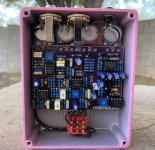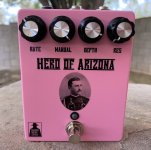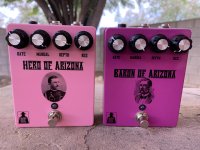blackhatboojum
Well-known member
- Build Rating
- 5.00 star(s)
As @Guardians of the analog put it in his epic build report, "Let's hack a Fraudhacker, shall we?" Yeah, that's right... Be jealous because the other half of the BBD Brothers for Life assembled the elusive HF-2 flanger as well. As Chris has already mentioned, this build came into fruition thanks to a lengthy discussion and deep dive into the circuit between him and I. Both of us were in agreement that a Boss HF-2 build was doable and a much needed flanger in our lives. When he sent me a message saying "I have a source for some MN3204s. You in?" My response was an emphatic "Hell yes!!" I seriously can't thank Chris enough for hooking me up with this unobtanium BBD. You rock man!
It's already been pointed out that the HF-2 is like the lite version of the BF-2 and yeah... I 100% agree with that analogy. It's more subtle, not quite as harsh, slightly sweeter, and not as boxy sounding. When used in front of distortion, the BF-2 is fat and sinister whereas the HF-2 feels and sounds less aggressive with some of the fat trimmed off. With a cleaner tone, the BF-2 is slightly fatter than the HF-2 and the latter has a more shimmery/pretty sound. The BF-2 has been the king of modulation for me for over 2 decades but, the HF-2 is now sharing the crown.
For the enclosure on this one, I went with a legend, jack of all trades, certified bad ass, and Arizona hero. William Owen (Buckey) O'Neill. O'Neill was born on February 2 1860 in St. Louis Missouri. Not much is known about his early life but, we do know that him and his family ended up Washington D.C. This is where O'Neill attended and graduated from law school. In the early part of 1879, O'Neill decided to move out west and arrived in the Arizona Territory in September of the same year. He was hired as a printer for the Phoenix Herald but, by late 1880, he wanted to experience the "Real West" and moved to Tombstone. He took a job working for the Tombstone Epitaph and as many did during this time, took up gambling in the common card game called Faro. This is where he got the nickname Buckey because he loved to play against the odds or "buck the tiger" as it was commonly referred to. Buckey bounced around for awhile but, eventually ended up in Prescott AZ in the spring of 1882. He became a court reporter, editor of the Arizona Miner weekly newspaper, and founded his own paper called the Hoof and Horn. In 1886 he became the captain of the local Arizona Militia unit called the Prescott Grays and later was serving as Yavapai County, AZ judge. In 1888 he was elected as Yavapai County sheriff and while serving as sheriff, captured four bandits who robbed an Atlantic and Pacific passenger train in Diablo Canyon. After his term of sheriff was up, he got into mining and was quite prosperous with several onyx mines for the next several years. He continued to write, producing pamphlets promoting the Arizona Territory and even wrote some short stories that were published in several newspapers and magazines. With politics not out of his system yet, Buckey ran for, and was unanimously elected, mayor of Prescott in 1897. When the Spanish-American War broke out in 1898, O'Neill mounted the first volunteer force of men from the Arizona Territory. He was made captain of Company A, 1st US Volunteer Cavalry, which would later be known as Teddy Roosevelt’s Rough Riders. On June 25, 1898, the Rough Riders saw their first action when O'Neill led his men at the front of the line in the Battle of Las Guasimas, capturing the Spanish flank. Him and his men would then move onto the Battle of San Juan Hill where unfortunately, a bullet would strike O'Neill in the head, ending his life at just 38 years of age.



It's already been pointed out that the HF-2 is like the lite version of the BF-2 and yeah... I 100% agree with that analogy. It's more subtle, not quite as harsh, slightly sweeter, and not as boxy sounding. When used in front of distortion, the BF-2 is fat and sinister whereas the HF-2 feels and sounds less aggressive with some of the fat trimmed off. With a cleaner tone, the BF-2 is slightly fatter than the HF-2 and the latter has a more shimmery/pretty sound. The BF-2 has been the king of modulation for me for over 2 decades but, the HF-2 is now sharing the crown.
For the enclosure on this one, I went with a legend, jack of all trades, certified bad ass, and Arizona hero. William Owen (Buckey) O'Neill. O'Neill was born on February 2 1860 in St. Louis Missouri. Not much is known about his early life but, we do know that him and his family ended up Washington D.C. This is where O'Neill attended and graduated from law school. In the early part of 1879, O'Neill decided to move out west and arrived in the Arizona Territory in September of the same year. He was hired as a printer for the Phoenix Herald but, by late 1880, he wanted to experience the "Real West" and moved to Tombstone. He took a job working for the Tombstone Epitaph and as many did during this time, took up gambling in the common card game called Faro. This is where he got the nickname Buckey because he loved to play against the odds or "buck the tiger" as it was commonly referred to. Buckey bounced around for awhile but, eventually ended up in Prescott AZ in the spring of 1882. He became a court reporter, editor of the Arizona Miner weekly newspaper, and founded his own paper called the Hoof and Horn. In 1886 he became the captain of the local Arizona Militia unit called the Prescott Grays and later was serving as Yavapai County, AZ judge. In 1888 he was elected as Yavapai County sheriff and while serving as sheriff, captured four bandits who robbed an Atlantic and Pacific passenger train in Diablo Canyon. After his term of sheriff was up, he got into mining and was quite prosperous with several onyx mines for the next several years. He continued to write, producing pamphlets promoting the Arizona Territory and even wrote some short stories that were published in several newspapers and magazines. With politics not out of his system yet, Buckey ran for, and was unanimously elected, mayor of Prescott in 1897. When the Spanish-American War broke out in 1898, O'Neill mounted the first volunteer force of men from the Arizona Territory. He was made captain of Company A, 1st US Volunteer Cavalry, which would later be known as Teddy Roosevelt’s Rough Riders. On June 25, 1898, the Rough Riders saw their first action when O'Neill led his men at the front of the line in the Battle of Las Guasimas, capturing the Spanish flank. Him and his men would then move onto the Battle of San Juan Hill where unfortunately, a bullet would strike O'Neill in the head, ending his life at just 38 years of age.



Last edited:


